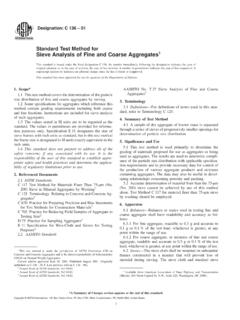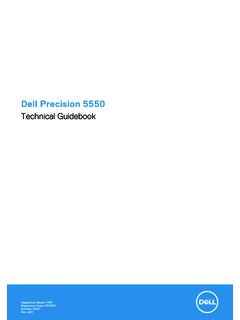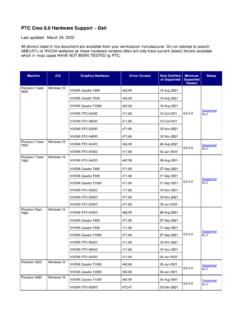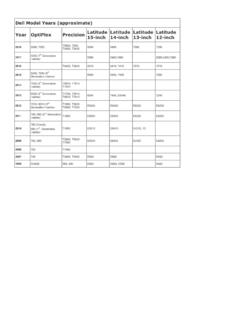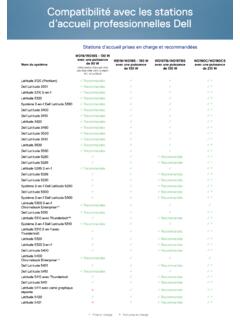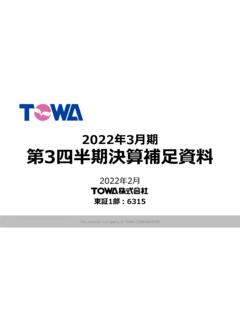Transcription of Standard Test Methods for Specific Gravity of Soil Solids ...
1 Designation: D 854 02 Standard Test Methods forSpecific Gravity of Soil Solids by Water Pycnometer1 This Standard is issued under the fixed designation D 854; the number immediately following the designation indicates the year oforiginal adoption or, in the case of revision, the year of last revision. A number in parentheses indicates the year of last reapproval. Asuperscript epsilon (e) indicates an editorial change since the last revision or Scope * These test Methods cover the determination of thespecific Gravity of soil Solids that pass the (No. 4)sieve, by means of a water pycnometer. When the soil containsparticles larger than the sieve, Test Method C 127shall be used for the soil Solids retained on the sieveand these test Methods shall be used for the soil Solids passingthe Soil Solids for these test Methods do not include solidswhich can be altered by these Methods , contaminated with asubstance that prohibits the use of these Methods , or are highlyorganic soil Solids , such as fibrous matter which floats in The use of Test Method D 5550 may be used to determine thespecific Gravity of soil Solids having Solids which readily dissolve in wateror float in water, or where it is impracticable to use Two Methods for performing the specific Gravity areprovided.
2 The method to be used shall be specified by therequesting authority, except when testing the types of soilslisted in A Procedure for Moist Specimens, describedin This procedure is the preferred method. For organicsoils; highly plastic, fine grained soils; tropical soils; and soilscontaining halloysite, Method A shall be B Procedure for Oven-Dry Specimens, de-scribed in All observed and calculated values shall conform to theguidelines for significant digits and rounding established inPractice D The procedures used to specify how data are collected/recorded and calculated in this Standard are regarded as theindustry Standard . In addition, they are representative of thesignificant digits that generally should be retained. The proce-dures used do not consider material variation, purpose forobtaining the data, special purpose studies, or any consider-ations for the user s objectives; and it is common practice toincrease or reduce significant digits of reported data to becommensurate with these considerations.
3 It is beyond the scopeof these test Methods to consider significant digits used inanalysis Methods for engineering The values stated in SI units are to be regardedas Standard . No other units of measurement are included inthese test Standard does not purport to address all of thesafety concerns, if any, associated with its use. It is theresponsibility of the user of this Standard to establish appro-priate safety and health practices and determine the applica-bility of regulatory limitations prior to Referenced Standards:C 127 Test Method for Specific Gravity and Absorption ofCoarse Aggregate2D 653 Terminology Relating to Soil, Rock, and ContainedFluids3D 1140 Test Method for Amount of Material in Soils FinerThan the No. 200 (75- m) Sieve3D 2216 Test Method for Laboratory Determination of Water(Moisture) Content of Soil and Rock by Mass3D 2487 Practice for Classification of Soils for EngineeringPurposes (Unified Soil Classification System)
4 3D 3740 Practice for Minimum Requirements for AgenciesEngaged in the Testing and/or Inspection of Soil and Rockas Used in Engineering Design and Construction3D 4753 Guide for Evaluating, Selecting, and SpecifyingBalances and Scales for Use in Soil, Rock, and RelatedConstruction Materials Testing3D 5550 Test Method for Specific Gravity of Soil Solids byGas Pycnometer3D 6026 Practice for Using Significant Digits in Geotechni-cal Data4E 11 Specification for Wire-Cloth Sieves for Testing Pur-poses5E 177 Practice for Use of the Terms precision and Bias inASTM Test Methods5E 691 Practice for Conducting an Interlaboratory Study toDetermine the precision of a Test Method53. For definitions of terms used in these test1 This Standard is under the jurisdiction of ASTM Committee D18 on Soil andRock and is the direct responsibility of Subcommittee on Texture, Plasticity,and Density Characteristics of edition approved July 10, 2002.
5 Published September 2002. Originallypublished as D 854 45. Last previous edition D 854 Book of ASTM Standards, Vol Book of ASTM Standards, Vol Book of ASTM Standards, Vol Book of ASTM Standards, Vol *A Summary of Changes section appears at the end of this ASTM International, 100 Barr Harbor Drive, PO Box C700, West Conshohocken, PA 19428-2959, United , refer to Terminology D of Terms Specific to This Gravity of soil Solids , Gs,n the ratio of themass of a unit volume of a soil Solids to the mass of the samevolume of gas-free distilled water at 20 Significance and The specific Gravity of a soil Solids is used in calculatingthe phase relationships of soils, such as void ratio and degreeof The specific Gravity of soil Solids is used to calculatethe density of the soil Solids . This is done by multiplying itsspecific Gravity by the density of water (at proper temperature). The term soil Solids is typically assumed to meannaturally occurring mineral particles or soil like particles thatare not readily soluble in water.
6 Therefore, the specific gravityof soil Solids containing extraneous matter, such as cement,lime, and the like, water-soluble matter, such as sodiumchloride, and soils containing matter with a specific Gravity lessthan one, typically require special treatment (see Note 1) or aqualified definition of their specific The balances, pycnometer sizes, and specimen massesare established to obtain test results with three The quality of the result produced by these test Methods isdependent on the competence of the personnel performing it, and thesuitability of the equipment and facilities used. Agencies that meet thecriteria of Practice D 3740 are generally considered capable of competentand objective testing/sampling/inspection/etc. Users of these test methodsare cautioned that compliance with Practice D 3740 does not in itselfassure reliable results.
7 Reliable results depend on many factors; PracticeD 3740 provides a means of evaluating some of those The water pycnometer shall be either astoppered flask, stoppered iodine flask, or volumetric flask witha minimum capacity of 250 mL. The volume of the pycnometermust be 2 to 3 times greater than the volume of the soil-watermixture used during the deairing portion of the The stoppered flask mechanically sets the volume. Thestoppered iodine flask has a flared collar that allows the stopperto be placed at an angle during thermal equilibration andprevents water from spilling down the sides of the flask whenthe stopper is installed. The wetting the outside of the flask isundesirable because it creates changes in the thermal equilib-rium. When using a stopper flask, make sure that the stopper isproperly labeled to correspond to the A balance meeting the requirements of GuideD 4753 for a balance of g readability.
8 When using the250 mL pycnometers, the balance capacity shall be at least 500g and when using the 500 mL pycnometers, the balancecapacity shall be at least 1000 Oven Thermostatically controlled oven, ca-pable of maintaining a uniform temperature of 11065 Cthroughout the drying chamber. These requirements usuallyrequire the use of a forced-draft Thermometer capable of measuring thetemperature range within which the test is being performed,readable to the nearest C and an immersion depth rangingbetween 25 to 80 mm. Full immersion thermometers shall notbe used. Either a general-purpose precision mercury thermom-eter or a digital thermometer with a 1 to 57 C range will meetthis A desiccator cabinet or large desiccator jarof suitable size containing silica gel or anhydrous It is preferable to use a desiccant that changes color toindicate when it needs Air Removal Apparatus To remove en-trapped air (deairing process), use one of the Plate or Bunsen Burner, capable of maintaining atemperature adequate to boil System, a vacuum pump or water aspirator,capable of producing a partial vacuum of 100 mm of mercury(Hg) or less absolute A partial vacuum of 100 mm Hg absolute pressure isapproximately equivalent to a 660 mm (26 in.)
9 Hg reading on vacuumgauge at sea Container A Styrofoam cooler and cover orequivalent container that can hold between three and sixpycnometers plus a beaker, a water bottle, and a is required to maintain a controlled temperature environ-ment where changes will be uniform and A non-corrosive smooth surface funnel with astem that extends past the calibration mark on the volumetricflask or stoppered seal on the stoppered flasks. The diameter ofthe stem of the funnel must be large enough that soil Solids willeasily pass (optional) A device to assist in adding deaired water to thepycnometer without disturbing the soil-water mixture. Thedevice may be fabricated as follows. Plug a1 4to3 8in. diameterplastic tube at one end and cut two small vents (notches) justabove the plug. The vents should be perpendicular to the axisof the tube and diametrically opposed. Connect a valve to theother end of the tube and run a line to the valve from a supplyof deaired No.
10 4 ( mm) conforming to the require-ments of Specification E (optional) A blender with mixing bladesbuilt into the base of the mixing Equipment, such as a computer orcalculator (optional), specimen dishes, and insulated of Water Distilled water is used in this testmethod. This water may be purchased and is readily availableat most grocery stores; hereafter, distilled water will be referredto as Test The test specimen may be moist or oven-dry soil andshall be representative of the soil Solids that passes the U. No. 4 sieve in the total sample. Table 1 givesguidelines on recommended dry soil mass versus soil type andpycnometer of such blenders include, but are not limited to, Waring Two important factors concerning the amount of soilsolids being tested are as follows. First, the mass of the soilsolids divided by its specific Gravity will yield four-significantdigits.
